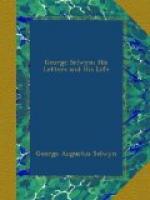In the chapter which contains the earliest of Selwyn’s letters to Frederick, Earl of Carlisle,* something must be said of the correspondence itself. It was begun in 1767, and most of the letters which Selwyn wrote to Lord and Lady Carlisle from that date to his death have been preserved at Castle Howard. The collection is in many respects unique. It records a great number of facts, many no doubt small and in themselves unimportant, which, however, in the aggregate form a lifelike picture of English society in the eighteenth century. The letters are written in the bright and unaffected manner which Madame de Sevigne, whose style Selwyn so much admired, had introduced in France. Filled with human interest and easily expressed, they differ materially from Walpole’s letters in that they are characterised by a greater simplicity, and a less egotistical tone. They show a keener interest in his correspondent. There is in them a delightful frankness, an unconventional freshness. Walpole’s correspondence, invaluable as it is, always bears traces of the preparation which we know that it received. But Selwyn, with a light touch, wrote the thoughts and impassions of the moment, never for effect. Walpole was often thinking of posterity, Selwyn always of his friends, who were numberless and who were in their time frequently his correspondents. How numerous Selwyn’s letters must have been we know from the number to him which have been published; but with the exception of those which have fortunately been preserved at Castle Howard, his appear to have perished.
* Frederick, fifth earl of Carlisle. 1748. Born. 1769. Married Lady Caroline, daughter of Lord Gower. 1777. Treasurer of Household. 1778. Commissioner to America. 1779. Lord of Trade and Plantations. 1780. Lord Lieutenant of Ireland. 1782. Lord Steward. 1783. Lord Privy Seal. 1825. Died.
The frequent French interpolations with which his letters are interspersed now strike us as affectations. They were, however, a fashion of the day; nor should we forget that Selwyn spent so much of his life in Paris that the language came to him as easily as his own.
In 1767 Selwyn and Carlisle had not long been friends. “Don’t lead your new favourite Carlisle into a scrape,” wrote Gilly Williams to Selwyn in the previous year. The words were written without serious intent, but they are noticeable because they are so opposite to the whole course of the rising friendship. The relations of the two men were remarkable.
It has been well said of Selwyn by a statesman of to-day that he was a good friend, a fact never better exemplified than in his friendship with Carlisle. In his affairs he took a greater interest than would be expected of the nearest of relatives, and with this he united a singularly warm and open-hearted affection not only for Carlisle but for his family. It lasted to the day of his death. There was between them, as Pitt said of his relations with Wilberforce, a tie of affection and friendship—simple and ingenuous and unbreakable.




